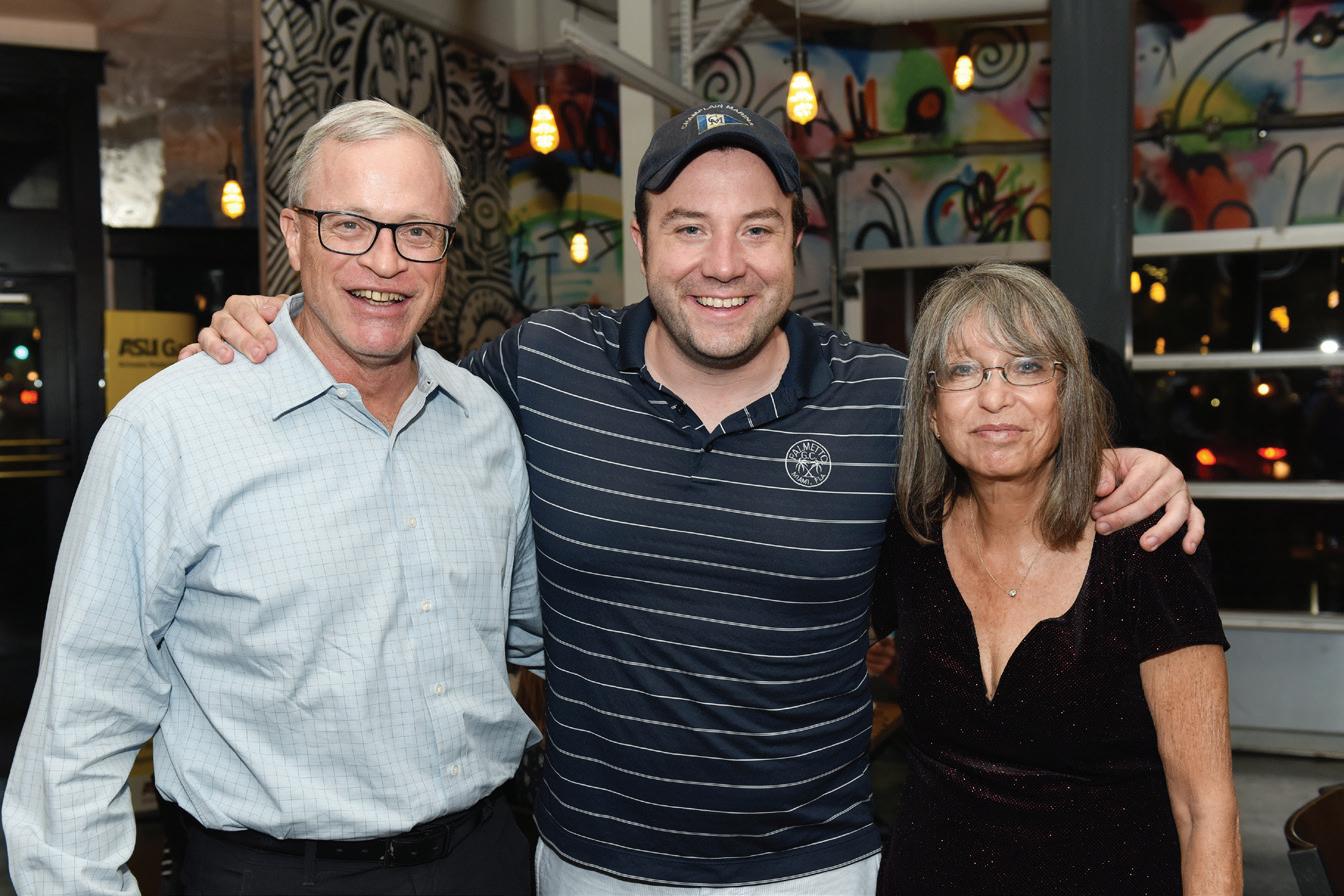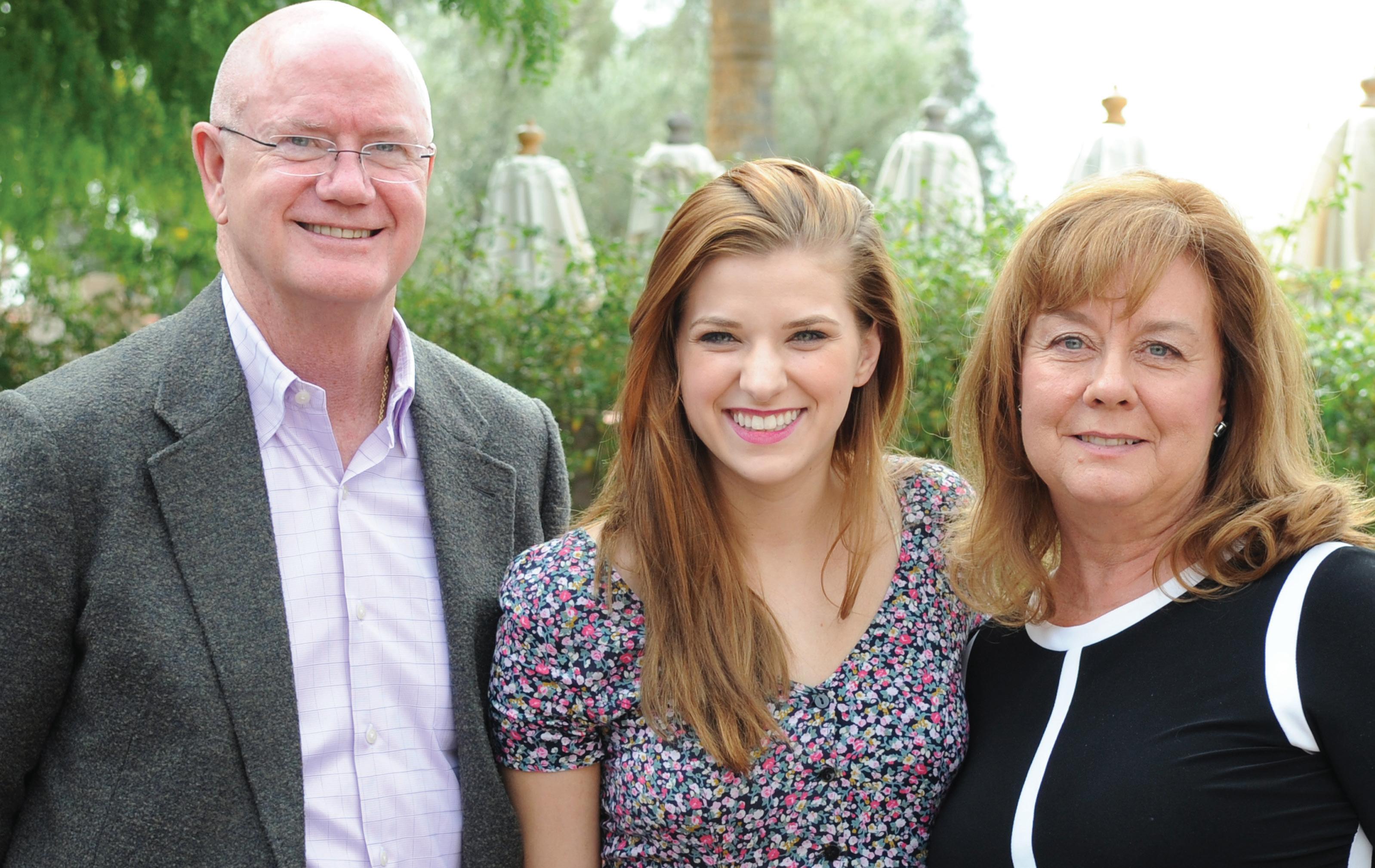
15 minute read
Equation
The Hasker The Hasker Equation Equation Donor Profile
Jennifer Hanland
Advertisement
Jay and Rojon Hasker with Danielle Wade, who played Dorothy in the National Tour of THE WIZARD OF OZ. It takes two. Rojon and Jay Hasker seem to embrace this sentiment in many endeavors. Along with their own, so many other lives they’re touching are the richer for it. Two happy roles ASU Gammage has been playing in the Haskers’ equation are provider and recipient.
Two Retirees
Jay retired ten years earlier than Rojon and he credits her with helping them begin to grow relationships with like-minded people outside of their professional lives.
The Haskers were moved to become more involved as donors years ago, “when Colleen and Michael did a presentation about the community outreach at ASU Gammage.” The concept of programs that focused on using the performing arts to educate and enrich the Valley’s youth connected with what Jay and Rojon held dear.
“Rojon put her niece into Camp Broadway that year,” Jay says, referring to the program comprised of distinguished actors, writers and designers directly from New York, who work with kids ages 10-17 for one week. Rojon further recalls one of the first Performances for Students event they attended was the Dance Theatre of Harlem.
“It was then that we grasped the impact ASU Gammage was having on the students. When the performance began it was so quiet you could hear a pin drop. After the show, even though the cast could only take ten or twelve questions, a 100 hands shot up every time,” she says.
Jay blends his memory with Rojon’s, saying, “From the respect their silence demonstrated to their ovations, we knew.”
Because she grew up in Alaska and Jay was raised in the Ozarks of Missouri, neither had big opportunities to be exposed to the performing arts. Rojon tells about the choir teacher in Anchorage who gave extra credit for students to attend cultural events like the French film festival. That same teacher urged her students to see JESUS CHRIST SUPERSTAR in 1973. The “somewhat controversial show at the time” stuck with Rojon.
Jay, still thinking about the Dance Theatre of Harlem and acknowledging he had even less arts exposure than Rojon as a child, says, “When you have been impacted by an arts experience and see children impacted that way as well, you have to pass it on.”
Two Extra Tickets
Once Rojon was also retired, it seems the Haskers began re-doubling their arts involvement.
Jay says, “We meet all kinds of different people through ASU Gammage. Mollie [Trivers, Senior Director of Development] and Michelle [Johnson, Executive Assistant] help bring me along. They always make sure I feel comfortable and sometimes they tell me what to expect.”
“They are masters at making people feel welcome,” Rojon adds.
Years ago, the Haskers developed another unique arts-enrichment habit. By purchasing four rather than two tickets to every show each season, the Haskers have built relationships small and grand. They offer people from all walks of life to share their ASU Gammage performance experiences along with them.
“One of the things about my wife is she believes in paying it forward. She wants to make sure we are helping others go forward, too,” Jay explains.
For instance, their adult grandchildren, ages 22 and 26, have first crack at the extra tickets and join the Haskers for a couple shows each season. They’ve already called dibs on DEAR EVAN HANSEN and WICKED for 2018-19. Last season, of course, the huge excitement was for HAMILTON.
From siblings and friends to their coffee shop barista and downstairs neighbors, the Haskers take people to ASU Gammage with them every time.
Two New York Jaunts
The Haskers have twice joined the ASU Gammage Broadway Adventure as they continue to deepen their connection to friends they’ve made. It’s a trip that includes opportunities to meet with Broadway actors, directors and producers and provides chances to get an insight into the industry.
“We learn where people come from; we learn about the education they have or don’t have. So often what we watch on stage is so different from the person.” ”There’s just so much there, so much to learn from the theater community,“ Jay says.
“It’s filled with people who have worked hard, been lucky and want to support others to do the same,” Rojon concludes.
The couple has built a support system through their ASU Gammage network that borders on the irreplaceable. They’ve also increased and deepened their support of ASU Gammage goals.
“Now and then, especially in this summer heat, the discussion about moving somewhere else comes up,” Rojon says. “But we don’t want to give up our community at ASU Gammage. It’s entertainment, it’s social and it’s learning. It keeps us engaged and sharper; we understand current issues better. We gravitate toward people like that.”
“We recently became even more interested in Beyond, primarily because of Michael, (Reed, Senior Director of Programs and Organizational Initiatives)” Rojon continued about the couple’s decision to underwrite one of the shows this season. “We are excited to be involved with BARBER SHOP CHRONICLES. Michael’s passion and enthusiasm always leads to the best programming.”
Circling back to the idea of having a pro-active retirement plan, Rojon reflects, “At work you have a built-in social structure. That automatic social contact is gone when you retire. There is a void to fill. At ASU Gammage, we are always around people who are very open and non-judgmental. They are fun to be around and they are optimistic.”
Jay and Rojon Hasker chat with ASU Gammage Executive Director Colleen Jennings-Roggensack at a donor lunch. Photo by Tim Trumble.

2018 Broadway Adventure
breaks the mold yet again and gives VIPs an inside look at NYC
John Lucking and Ray and Lena Mogensen learn about the historic restoration work of Evergreene Studios in Brooklyn.

L to R: Rojon and Jay Hasker, Craig Thatcher, and Ken Schutz in a Broadway rehearsal studio after hearing from stars of HELLO, DOLLY !, COME FROM AWAY and CAROUSEL .

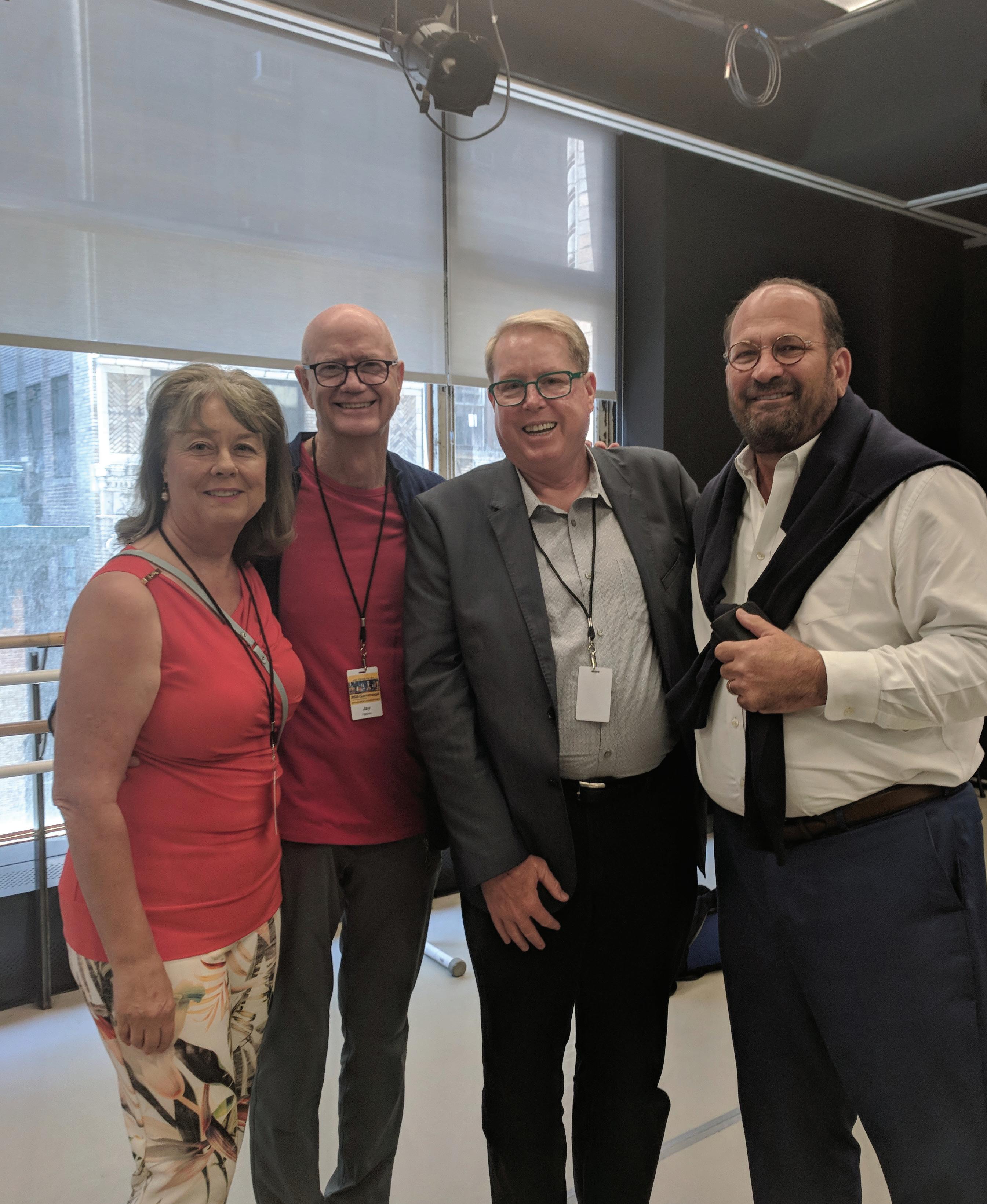
ASU Gammage VIP donors regroup for a full day exploring the City.
Soul Sisters

Members of Gila River Culture and Language Teacher Cohort support each other and their community as they earn their master’s degrees
From left: Priscilla Espinoza, Marcella Hall, Edwardine Thomas, Nina Allison and (not pictured) Starleen Somegustava have formed a close relationship through the Gila River program.
STORY BY
BOB YOUNG
In the 1950s, after the Indian Relocation Act was enacted, Priscilla Espinoza’s family moved from the Gila River Indian Community in the far southeast Valley to Southern California.
She met her husband, Phillip, there. They raised six kids. And they felt the sting of discrimination and racism that was commonplace to her people in those days. They became activists, joining the Brown Berets, a group modeled after the Black Panthers in the 1960s.
Espinoza was marching with them in Los Angeles during August 1970 when two activists and newspaper editor Ruben Salazar were killed. Salazar was struck by a tear-gas canister fired by a sheriff’s deputy.
“I was there, marching and dodging tear gas,” she says. “It really did make an impact, and a lot changed in Southern California. Because of that big march they started getting more minority teachers, and there was a big push for equal education.”
She put her own higher education, however, on the backburner. Through it all, she never forgot her place PHOTOS BY DEANNA DENT among the Akimel O’otham people in Arizona.
“I never lost my identity when I left,” Espinoza says. “I take it with me wherever I go.”
After Phillip, to whom she was married for 42 years, passed away seven years ago, the 69-year-old greatgrandmother of two and grandmother of six felt a pull from home and a push from her late husband, who had told her to “keep going, keep living.”
“He was my greatest supporter,” she says.
Now she is among five women from the Gila River Indian Community who call themselves the “soul sisters.” Soon, they will be the graduating grandmas and mothers — and remarkable role models for the people of their community and beyond.
Ranging in age from 36 to 69, Espinoza, Edwardine Thomas, Nina Allison, Marcella Hall and Starleen Somegustava are completing work on Master of
Interdisciplinary Studies degrees as members of the Gila River Culture and Language Teacher Cohort, a partnership between Arizona State University’s Center
example. ” — NINA ALLISON
for Indian Education, New College of Interdisciplinary Arts and Sciences and the Gila River Indian Community Tribal Education Department. The first-of-its-kind program trains future teachers on their home reservation with a focus on tribal history and keeping alive the Akimel O’otham language.
The group has formed a tight bond.
“We have all been through a lot of stuff together,” says Thomas, a 56-year-old grandmother of four. “These are my sisters. We’ve gone through a lot of stuff. We’re still going through a lot of stuff. Every week we come to class and we lean on each other.”
All have experienced similar challenges while pursuing their education — from getting back into good study and attendance habits, to feeling a sense of responsibility for their immediate and extended families that is such an important piece of their culture, to balancing work and school, to solving the mysteries that are laptop computers and PowerPoint presentations.
Perhaps the greatest challenge was simply believing that, despite their age and responsibilities, they could achieve an advanced degree from ASU.
“I’ve been going to school off and on since 2014, starting at South
Mountain (Community College), and I would say this year has been the most stressful year ever,” says Hall, 36, a cultural instructor for fifth- through eighth-grade students at Sacaton Middle School, about an hour south of Phoenix. She has a daughter and is caring for a niece and nephew.
“I’m handling it, and it’s hard,” she adds. “Coming here and letting the ladies know and having their support, it gets easier.”
Espinoza and Thomas are the elders of the group. Each happened upon the cohort by happenstance.
“I always tell people I’m a lifelong learner,” Thomas says. “I’ve been going to school since after high school. I went to college for one year but had to drop out, just for family things. I had to take care of my siblings. So
I had to work.”
She has worked for 26 years at the Blackwater Community School in Coolidge. When she attended an in-service teacher training program at the Wild Horse Pass Hotel and Casino, it led her back to school.
“There were people there from South Mountain (Community College), and they asked if any people were interested in obtaining their degrees,” she says. “So that’s where it started.”
Now, she is the only member of her family to earn a college degree. Her work at Blackwater focuses on making home visits to people in the community and working with parents and children to reach childdevelopment milestones in gross and fine motor skills and language.
“We incorporate the O’otham language in our visits because a lot of the parents do not know our language,” she says. “So they learn along with their kids.”
She says her ultimate goal is to establish a full-immersion school in the Gila River Indian Community that all of the soul sisters might someday work at.
To that end, the women will join forces this summer to bring together members of the community’s seven districts for a camp that would immerse participants in the O’otham language and culture.
“We’re going to try to do it for three weeks and see how that goes,” Thomas says. “The rest of my cohort members are going to be in on that, too.
“It’s going to be limited to about ten families per district, and hopefully this will be like a steppingstone for other people to come and join our group, because we’re open to anyone helping us — other community members that are fluent in language or dances or basket making.”
When Espinoza returned to the area to be near one of her sons living in Maricopa, she paid a visit to the Gila River Indian Community Governance Center to complete some paperwork. She and her husband had hoped to retire in the community.
“I had retired from a school district in California, where I was a special education (instructional assistant),” she says. “I was at the Governance Center to talk to a lady about my paperwork. I wasn’t looking for a job. This
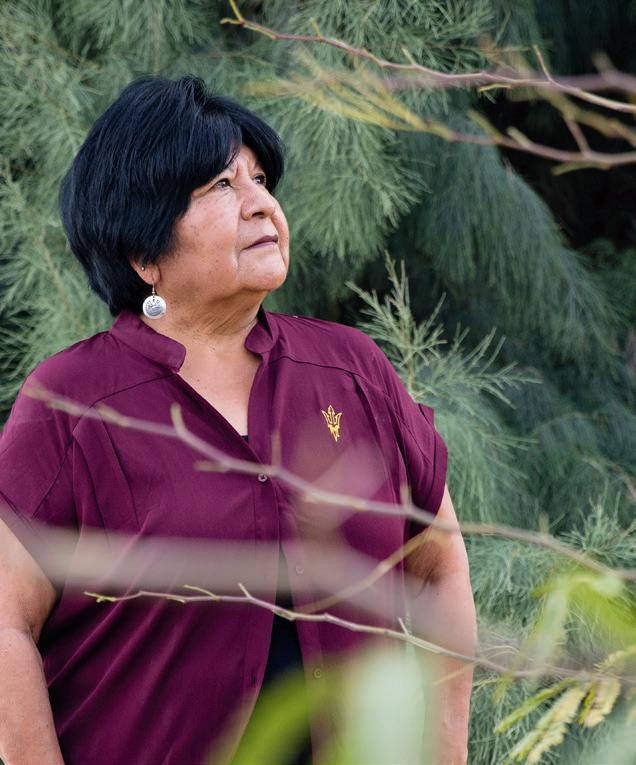
young lady was putting up flyers that said ‘special needs (teacher) urgently needed.’
“I said, ‘I used to do that for years.’ Long story short, they interviewed me that day, got my paperwork and hired me on the spot.”
She was asked to work with a young boy with cerebral palsy, who couldn’t walk or talk.
“He could only say ‘mama’ “We incorporate the and ‘no,’ ” she says. “I put all my energy into this little boy... O’otham language in our I would see him every morning visits because a lot of the and say, ‘Good morning, what is parents do not know our your name? My name is Priscilla.’ I said that over and over for six language. So they learn months. One morning I said, ‘Hi, along with their kids.” buddy,’ and he looked at me and — EDWARDINE THOMAS said, ‘Hi, ’scilla!’ Oh my gosh, I knew then that this is it.”
Gregory Mendoza, who was Gila River Indian Community governor at the time, came to visit Casa Blanca Community School in Bapchule, where Espinoza works, and told her he had received a report about her work with the young boy, who now uses a walker.
“He said, ‘I want you to get into this program we have going on, this cohort. We want you to get your degree. We need people like you to help our people here.’ So that was it,” Espinoza says.
The women in the cohort — many of whom are able to participate because of private giving — agree that they are motivated most by what they represent for their families and community members. Espinoza says the cohort members hope their successes will “snowball.”
“When family members see each one of us, the five of us, I think it will trickle down,” she says. “It will snowball, pick up momentum. That’s what we’re hoping for.”
“I tell my students, ‘Don’t be a statistic,’” Hall adds. “We have a lot of high school dropouts, and not many of our people are going to college. I say, ‘Make your people proud. Make your family proud of you. We need our people in our communities sitting in the seats we are in as teachers, as educators, as tribal council members. You are all going to be filling our seats.’”
Allison, a mother of four and grandmother of three, briefly stopped her studies in the program when a nephew was killed in a car accident. He had just graduated from high school.
The desire to set an example for others kept her from giving up.
“I didn’t do homework. I didn’t do readings. That was a struggle for me,” she says. “... I told myself I had to get back on track. You do it for your kids. You do it for your family. You’re that role model. You’re that example.
“You have ups and downs and have struggles, but you go on.”
Thomas tells young people to get their education while they’re young instead of waiting like the members of the cohort.
“If I could turn back time, I wish I would have stayed in school and finished (college) after high school,” she says. “(I tell them) ‘You can do it. Just set your priorities straight and know your family will always be behind you.’”

NATIVE NATION Written by Larissa FastHorse Directed by Michael John Garcés
April 27-28 at 2 p.m. & 7 p.m. Phoenix Steele Indian School Park An Indigenous theatrical experience for the whole family. Join the original people of this land at significant locations around Phoenix to see the world through their eyes. Part marketplace, cultural performance, community gathering and theater, NATIVE NATION is a new experience every time that will forever change the way you see this land.
Generously sponsored by APS.
NATIVE NATION was made possible with funding by the New England Foundation for the Arts’ National Theater Project, with lead funding from the Andrew W. Mellon Foundation.


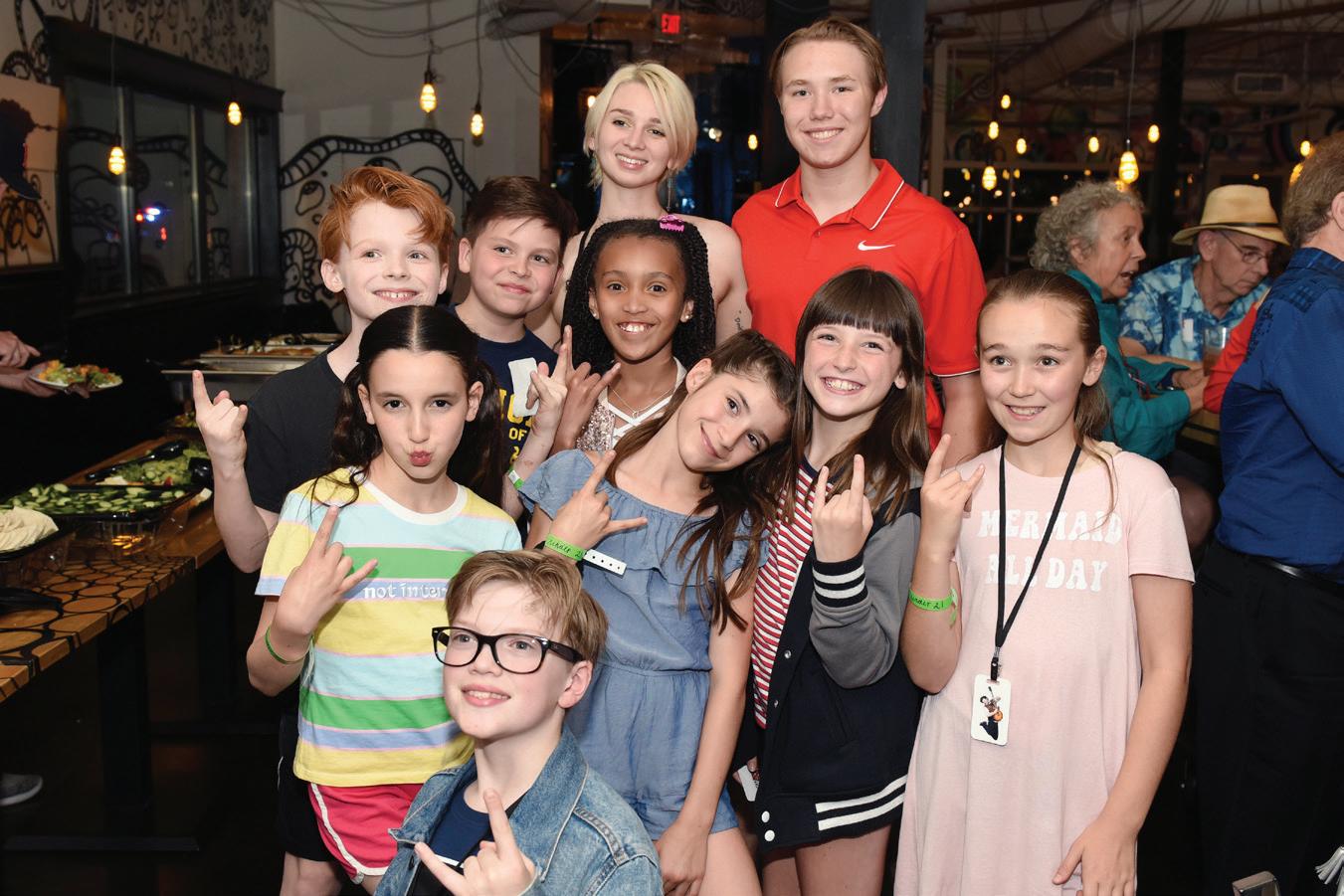
Opening Night Party at Pita Jungle

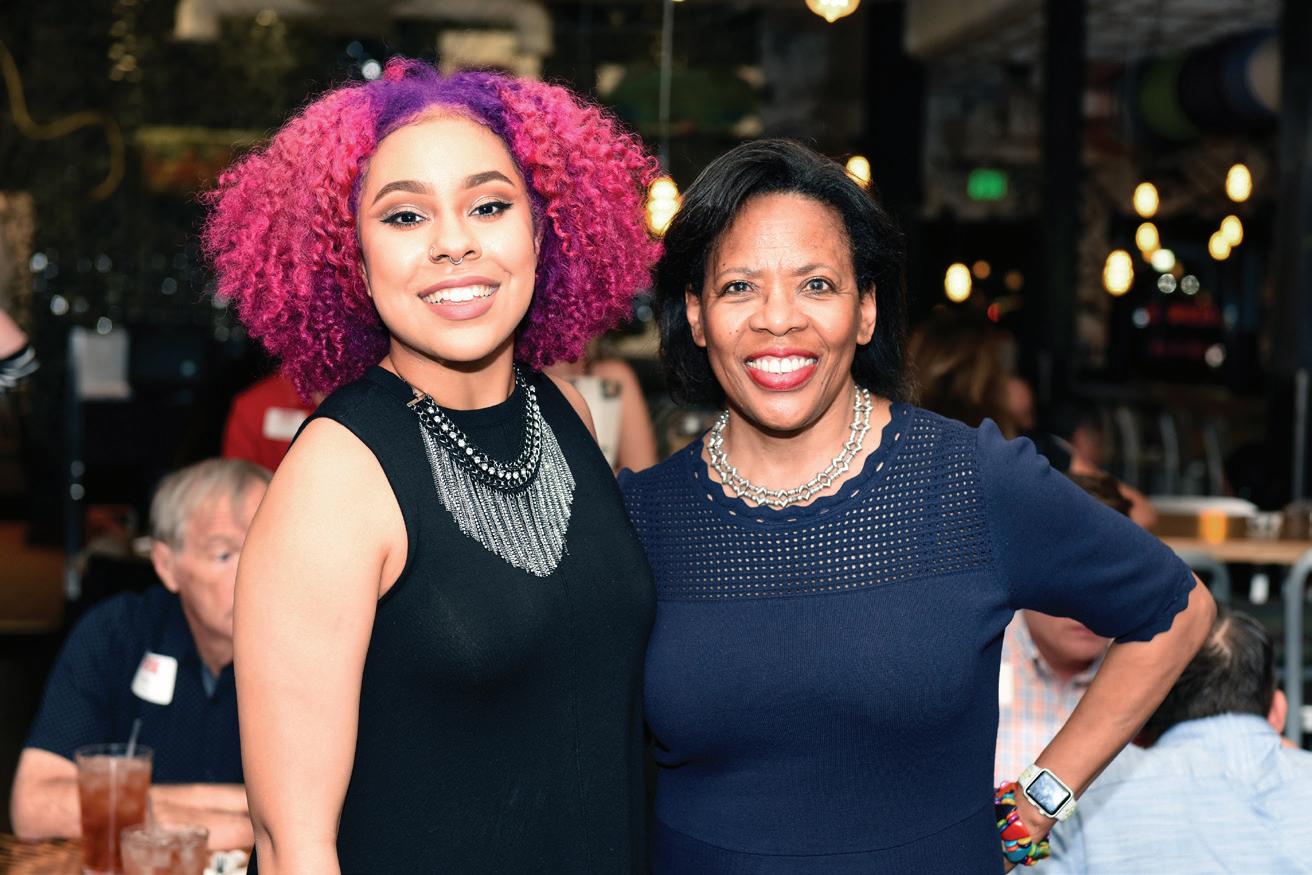
1. Jeff Rich with the young cast members 2. L to R: Bella Fraker (Understudy), Vincent Molden (Zack), Ava Saba, Lily Saba, Jesse Sparks (Understudy) 3. Amelia Corwin and Corwin Hemmingsen with the young cast members 4. Phoebe Koyabe with Colleen JenningsRoggensack 5. L to R: Bryan Hill, Merritt David Janes (Dewey), Leah Pallin-Hill 6. Helen & Joe Goldblatt with the young cast members Photos: Tim Trumble

